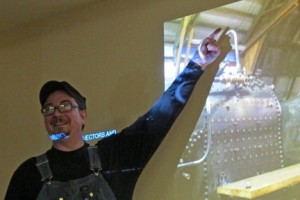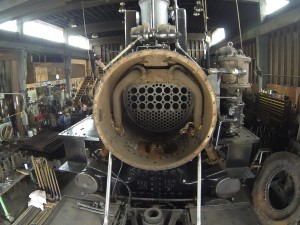by Rich Blake / Photos by Al Frasch
We kicked off the March clinic with a short discussion on recent and upcoming events. One recent event of note was the 10th Annual Pacific Model Loggers Congress at the Camp 18 Restaurant in Elsie Oregon held March 2nd. Rich Blake attended the meet and gave a report on some of the fun things to see and do in that part of the country especially the vast collection (his words “butt-ton”) of logging equipment on the Camp 18 property. It is a great place to go if you are researching logging history and would like to view and inspect prototype equipment. e also did our duty and reminded everyone about the Regional PSX Tacoma Event in June.
This clinic was very special in that our feature clinician was none other than the Chief Mechanical Officer of the Mount Rainier Scenic Railroad – Stathi Pappas. His clinic, titled “Steam Locomotive Systems and Technology” was a fascinating look into the inner workings of steam locomotives and how you can apply the prototype’s systems to more accurate modeling. Stathi is not only a vast storehouse of knowledge as one of the few people in the US that has rebuilt several steam locomotives for operation, he is also an adept and entertaining speaker. We got to hear quotes like “Why would anyone want to burn goofy black rocks??” in reference to coal locos and “Baldwin was the Ford of locomotive builders” you can guess what that means.
Stathi enforced the point that understanding locomotive systems is key to proper detailing on models. He talked about the difference between “Superdetailing” and “Stuperdetailing” where in the latter example too much stuff does not a better model make if it doesn’t make sense with the rest of the systems. He used several photos to describe the various systems and how they operate. More importantly he also described “why” things are the way they are on the various locomotives. Sometimes it is aesthetics and sometimes it is function with the point being that every time a locomotive came out of a repair or rebuild cycle, it was always different than when it went in. We got into a lot of specifics and it was a very interesting discussion with many club members asking a lot of questions about loco systems. Stathi covered many detailed topics including:
All of the photos Stathi used were of MRSR locomotives and his own personal locomotive – the “Chiggen” a former Santa Cruz Portland Cement Porter 0-4-0T that Stathi rebuilt from the ground up including fabricating a new boiler. (see more on this loco here: www.scpc2.com) The pictures themselves were amazing in that they detailed many areas of locomotives during the rebuild phase that are not normally seen in finished form.
He concluded the presentation by reiterating the fact that understanding the systems and knowing that everything on a loco is the way it is for a reason makes for better modeling and it is all up to the modeler as to how far they want to go with their individual detailing. He then spent another hour answering questions of which there was a plethora. Overall it was one of the best and most informative prototype clinics we have ever had. Hats off to Stathi for taking the time and allowing us the opportunity to dive into and learn about the fascinating subject of steam locomotive technology with a true expert in the field.
If you would like to see some of Stathi’s projects in action then come out to the Mount Rainier Scenic Railroad this May 17th for the special “Steam Up” event. The goal is to have no less than six operating steam locomotives running for photo shoots and run bys. This should be a “must do” event for any steam fan and especially any of us in the Pacific Northwest since it is virtually in our back yard. Check out the schedule at www.mrsr.com.




No Comments Yet